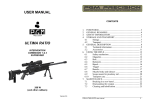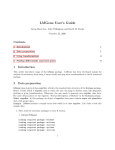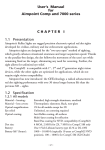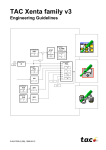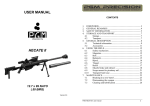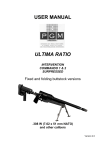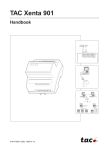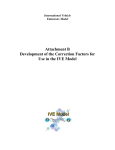Download Aimpoint T1 Engineering Paper (2 Page)
Transcript
CHAPTER I 1.2 SPECIFICATIONS 1.1 PRESENTATION Optical System Aimpoint Micro T-1 Reflex Sight is a small, light and rugged red dot sight developed mainly for military and law enforcement applications. Aimpoint red dot sights are designed for the ”two eyes open” method of sighting, which greatly enhances situational awareness and target acquisition speed. Thanks to the parallax-free design, the dot follows the movement of the user’s eye while remaining fixed on the target, eliminating any need for centering. Further, the Micro T-1 allows for unlimited eye-relief and is compatible with 1st , 2nd and 3rd generation night vision devices. The Aimpoint Micro T-1 uses the Advanced Circuit Efficiency Technology, called ACET, which combines Aimpoint’s superior accuracy and ease of use with significantly lower power usage. With the Micro T-1 sight, Aimpoint has introduced an aiming system that gives the performance of our full-sized sights in the smallest package possible. Operating Principle: Optical Magnification: Clear Aperture: Aiming Dot Size: Optical Coating: Dot Brightness: Dot Color: Optical Signature: Power Source Battery Type: Battery Life, typical: 1 2 3 Passive Red Dot Collimator Reflex Sight 1 x, unlimited eye relief 20 mm 2 MOA1 (0.6 mRad) or 4 MOA1 (1.2 mRad) Anti reflex and Band Pass coatings, NVD2 compatible 12 settings - 4 NVD and 8 Daylight settings of which 1 Extra Bright, Dot brightness manually adjusted Red (650 nm wavelength) No forward optical signature from the dot beyond 10 meters One 3 V lithium Battery, type CR2032, commercially available Over 5 years of continuous (day and night) use at pos 8 of 12 and over 10 months at pos 10 of 12. Typically 500 000 h3 at NVD setting. Storage battery 10 years MOA: Minute Of Angle, 1MOA~ 30 mm at 100 m or ~1” at 100 yards NVD: Night Vision Device Values valid at room temperature and for a quality battery. Physical Specifications Dimensions (L x W x H): Height of optical axis: Weight: Lens Covers: Adjustment: Material – Housing: Material - Lens Covers: Radioactive Materials: Hazardous Materials: 62 mm x 41 mm x 36 mm (2.4” x 1.6” x 1.4”), Sight only 62 mm x 41 mm x 40 mm (2.4” x 1.6” x 1.6”), Sight with Mount 18 mm (0.7”) over top surface of Picatinny Rail 84 grams (3.0 oz) Sight only, 105 grams (3.7 oz) Sight with Mount Lens Covers will add 7 mm (0.3”) to the length and 10 grams (0.4 oz) to the weight Range ±1 m at 100 meters (±1 yds at 100 yds) in windage and elevation, 1 click=10 mm at 80 meters =13 mm at 100 meters = 1/2” at 100 yds Extruded, high strength aluminum, hard anodized, black to dark gray, non-glare finish Rubber, black, non-glare finish None (Tritium 0%, Thorium 0%, Thorium Fluoride 0%) None (Mercury 0%, including battery) Mechanical Interface Keyed mount: Maintainability Mean Time To Repair: Mount for MIL-STD 1913 Rail System “Picatinny Rail” included for T-1 1.3 LOCATION AND DESCRIPTION OF MAJOR COMPONENTS See figure -45° C to +71° C (-50° F to +160° F) Fully waterproof Not affected by weapons cleaners, lubricants, oil or insect repellants OPERATION UNDER NORMAL CONDITIONS 2.1 ASSEMBLY AND PREPARATION FOR USE WARNING: Insure the weapon is unloaded and the safety selector is in the ”safe” position before attempting to install, remove or perform maintenance on the sight. Less than 0.5 h at field level (MTTR) 2.1.1 Installing Battery a) Remove Battery Cap (2) by turning it counter clockwise. b) Insert a battery (type CR2032) with positive (+) end toward Cap. CAUTION: Install the battery in the battery compartment carefully. Open the Battery Cap (2). Inspect that the current O-ring is not damaged. Failure to do so could result in water leakage into the battery compartment. c) Install Battery Cap (2) by turning clockwise until snug. Tighten with the provided Tool (9B) only. d) Verify that red dot is present by turning the Rotary Switch (4) clockwise. 2.1.2 Installing Sight on the weapon The Micro Sight is designed for installation on most types of weapons, which have a MIL-STD 1913 Picatinny Rail or Weaver Rail. If your weapon does not have or support an appropriate base(s), please consult your dealer, gunsmith or other qualified source. Environmental Specifications Temperature Range, Operating and Storage: Water Resistance: Chemical Resistance: CHAPTER II 1. Adjustment Cap (2 pcs) 2. Battery Cap 3. Battery (type CR2032) 4. Rotary Switch 5. Adjustment Screw 6. Base 7. Screws (4 pcs) for Base 8. Lens Cover, rubber 9. Tool (3 functions) 10.Shaft (for Base) 11.Locking Bar 2.1.2.1 Installing Sight on a Picatinny Rail a) Loosen the Shaft (10) by means of the Tool (9C), so that the Locking Bar (11) can clamp around the Picatinny Rail. b) Install the Sight to the weapon Rail by tightening the Shaft (10). First, ensure that the Sight is correctly positioned and that the Shaft (10) (=recoil stop) fits into a groove on the Picatinny Rail. To make sure that the Shaft is firmly tightened, screw the Shaft (10) clockwise until a light resistance can be encountered. After that, screw another 1/4 to 1/2 turn. NOTE: Each click of the Adjustment Screw (5) corresponds to a 13 mm movement of the point of impact at 100 meters, (3 mm at 25 meters and 26 mm at 200 meters or 1/2” at 100 yds). WARNING: Do not overtighten. c) When using Lens Covers (8), ensure that they are correctly positioned and can easily be opened. d) Finally, make sure that the Shaft (10) with Locking Bar (11) is firmly tightened around the weapon Rail. e) Complete zeroing according to 2.2.1 below. d) Insert either the two knobs on top of the Adjustment Cap (1) or the two knobs on the Tool (9A) in the two holes on the Adjustment Screw (5) and turn as follows: –– To move the point of impact to the right, turn windage adjustment screw counter clockwise –– To move the point of impact to the left, turn windage adjustment screw clockwise –– To move the point of impact up, turn elevation adjustment screw counter clockwise. –– To move the point of impact down, turn elevation adjustment screw clockwise. e) Confirm zeroing by firing at least three shots at a zeroing target. Check points of impact on zeroing target to confirm accuracy and repeat above procedure if required. f) After initial firing, ensure that the sight is secure. g) Turn Rotary Switch (4) to position 0 (counter clockwise). h) Close front and rear Lens Covers (8). 2.1.3 Lens Covers In order to preclude the loss of the lens covers when removed from the optical path of the Sight, the lens covers should be removed downwards. The rubber string will then grab around the Sight and Base. 2.2 OPERATING PROCEDURES 2.2.1 Zeroing The Micro Sight is delivered with the red dot in a centered position. Normally this means that only small adjustments are necessary, providing that the weapon rail (Picatinny Rail) is properly aligned. CAUTION: Do not continue to adjust windage and elevation mechanisms if you encounter resistance. The Elevation Adjustment Screw (5) is located on top of the sight, while the Windage Adjustment Screw (5) is located on the right side. a) Open (remove) Lens Covers (8). b) Turn the Rotary Switch (4) clockwise until the red dot has a sufficient intensity to contrast against the target. c) Remove the Adjustment Cap (1) for windage and elevation adjustment, one at a time. Either the two knobs incorporated on top of the Adjustment Cap (1) or the Tool (9A) shall be used for adjusting the Adjustment Screw (5). Reverse the Adjustment Cap (1) and the knobs will fit into the two recesses on the Adjustment Screw (5). CHAPTER III OPERATION UNDER EXTREME CONDITIONS a) Extreme heat (moist or dry). No special procedures required. b) Extreme cold. Extreme cold might shorten battery life. It could also make the Rotary Switch (4) a little harder to turn than at normal temperatures. c) Salt air. No special procedures required. d) Sea spray, water, mud and snow. Ensure that Battery Cap (2) and the two Adjustment Caps (1) are tightened before exposing the Sight to sea spray, mud, snow or before immersing the sight in water. Tighten the 2 Adjustment Caps (1) by hand, and use the Tool (9B) to tighten the Battery Cap (2). Keep Lens Covers (8) closed when sight is not being used. Clean lenses with lens paper/cloth and wipe the sight dry as soon as possible after exposure to water, sea spray, mud or snow. e) Dust storms and sand storms. Keep Lens Covers (8) closed when sight is not being used. f) High altitudes. No special procedures required. CAUTION: The lenses shall never be cleaned with fingers but with lens paper/cloth. If no lens paper/cloth available : –– To clear away debris (sand, grass etc): blow away the dirt. –– To clean lenses: mist up the lenses and clean them with a soft piece of cloth. CHAPTER IV TROUBLE SHOOTING PROCEDURES 4.1 RED DOT DOES NOT APPEAR Discharged Battery: Battery installed incorrectly: Battery is not making good contact: Defective Rotary Switch: The Battery Cap is not enough tightened: 4.2 IMPOSSIBLE TO ZERO Adjustment screw is at its limit: Impact point is moving: Replace Battery. Remove and reinstall Battery with (+) toward Cap. Clean contact surfaces and reinstall Battery. Notify dealer/armourer. Tighten the Battery Cap so that it gets in contact with the bottom of the Battery Housing. Check alignment of Mount to Barrel. Check Mount and Weapon Rail (or Carry Handle) stability. CHAPTER V MAINTENANCE a) This reflex sight does not require any particular maintenance while used under normal conditions. b) Under severe weather conditions please refer to chapter III. c) Keep lens covers closed whenever the sight is not in use. d) Warehouse storage: Remove battery and allow lens surfaces to dry completely (if wet) before closing the lens covers. e) To clean lenses refer to CAUTION in CHAPTER III. f) To reach maximum protection level for all weather conditions, wax is added into the rubber mixture. The wax will slowly migrate to the surface of the part. During frequent use this wax will be used up completely and not noticed by the user. For long time storage, the wax will not be used up as frequently and will be seen as a grey film on the surface. To restore to its original condition, please hand wash in warm dishwater. Operator’s and Maintenance Manual for AIMPOINT MICRO T-1 IMPORTANT INSTALLATION INSTRUCTIONS To avoid damage to the sights and for the proper assembly of the mount on the sight, shall the small original screws (M3x4) only be tightened by hand and with the attached micro tool. To do this: 1. Turn the sight upside down. Hold it in your hand with the screw holes up. 2. Press the mount against the sight and check that there is no gap. 3. Apply locking compound to the threads and install the screw in the mount. WARNING: Do not overtighten. 4. Mount the Screws crosswise. Tighten each Screw until resistance is felt. Rotate the Bolt Head an additional 1/4 turn to fully tightened. This is equivalent to 1.0Nm +0.2Nm of torque. Aimpoint AB Jägershillgatan 15 SE- 213 75 Malmö, Sweden Phone +46 (0)40 671 50 20 Fax +46 (0)40 21 92 38 e-mail: [email protected] www.aimpoint.com Aimpoint Inc. 14103 Mariah Court Chantilly, VA 20151-2113, USA Phone +1 703-263-9795 Fax +1 703-263-9463 e-mail: [email protected] www.aimpoint.com © Copyright 2014. Contents property of Aimpoint. All rights reserved. [12034-4]













